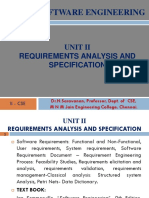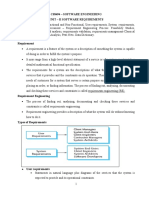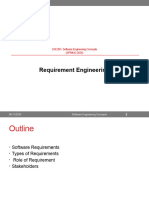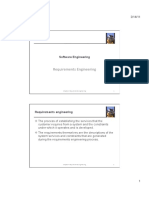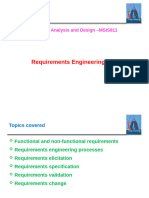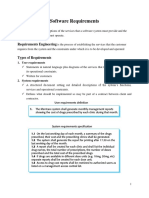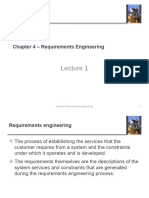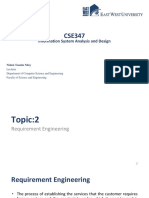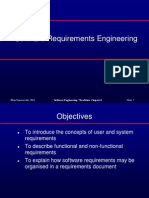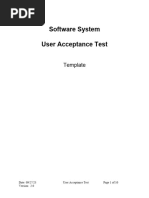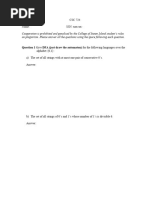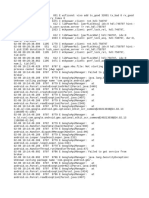SE Requirements (Part1)
SE Requirements (Part1)
Uploaded by
SAICopyright:
Available Formats
SE Requirements (Part1)
SE Requirements (Part1)
Uploaded by
SAIOriginal Title
Copyright
Available Formats
Share this document
Did you find this document useful?
Is this content inappropriate?
Copyright:
Available Formats
SE Requirements (Part1)
SE Requirements (Part1)
Uploaded by
SAICopyright:
Available Formats
Objectives
To introduce the concepts of user and system requirements
To describe functional and non-functional requirements
To explain how software requirements may be organised in
a requirements document
04/24/23 CSC430-Fall 2019 Prof. Zhanyang Zhang 3
What is a requirement?
It may range from a high-level abstract statement of a
service or of a system constraint to a detailed mathematical
functional specification.
This is inevitable as requirements may serve a dual
function
May be the basis for a bid for a contract - therefore must be
open to interpretation;
May be the basis for the contract itself - therefore must be
defined in detail;
Both these statements may be called requirements.
04/24/23 CSC430-Fall 2019 Prof. Zhanyang Zhang 4
Types of requirement
User requirements
Statements in natural language plus diagrams of the services
the system provides and its operational constraints. Written
for customers.
System requirements
A structured document setting out detailed descriptions of
the system’s functions, services and operational constraints.
Defines what should be implemented so may be part of a
contract between client and contractor.
04/24/23 CSC430-Fall 2019 Prof. Zhanyang Zhang 5
Definitions and specifications
User requirement
1. The software must provide a means of representing and accessing
1. external files created by other tools.
Syst em requir ements specification
1.1 The user should be pr o vided with facilities to define the type of
1.2 external files .
1.2 Each e xternal file type ma y hav e an associa ted tool w hich ma y be
1.2 applied to the file .
1.3 Each e xternal file type ma y be r epr esented as a specific icon on
1.2 the user’ s displa y.
1.4 F acilities should be pr o vided f or the icon r epr esenting an
1.2 e xternal file type to be defined b y the user .
1.5 When a user selects an icon r epr esenting an e xternal file , the
1.2 effect of that selection is to apply the tool associated with the type of
1.2 the external file to the file represented by the selected icon.
04/24/23 CSC430-Fall 2019 Prof. Zhanyang Zhang 6
Functional and non-functional requirements
Functional requirements
Statements of services the system should provide, how the system should
react to particular inputs and how the system should behave in particular
situations.
Non-functional requirements
constraints on the services or functions offered by the system such as
timing constraints, constraints on the development process, standards,
etc.
Domain requirements
Requirements that come from the application domain of the system and
that reflect characteristics of that domain.
04/24/23 CSC430-Fall 2019 Prof. Zhanyang Zhang 7
Functional requirements
Describe functionality or system services.
Depend on the type of software, expected users and the
type of system where the software is used.
Functional user requirements may be high-level
statements of what the system should do but functional
system requirements should describe the system services in
detail.
04/24/23 CSC430-Fall 2019 Prof. Zhanyang Zhang 8
The LIBSYS system
A library system that provides a single interface to a
number of databases of articles in different libraries.
Users can search for, download and print these articles for
personal study.
04/24/23 CSC430-Fall 2019 Prof. Zhanyang Zhang 9
Examples of functional requirements
The user shall be able to search either all of the initial set of
databases or select a subset from it.
The system shall provide appropriate viewers for the user to
read documents in the document store.
Every order shall be allocated a unique identifier
(ORDER_ID) which the user shall be able to copy to the
account’s permanent storage area.
04/24/23 CSC430-Fall 2019 Prof. Zhanyang Zhang 10
Non-functional requirements
These define system properties and constraints e.g.
reliability, response time and storage requirements.
Constraints are I/O device capability, system
representations, etc.
Process requirements may also be specified mandating a
particular CASE system, programming language or
development method.
Non-functional requirements may be more critical than
functional requirements. If these are not met, the system is
useless.
04/24/23 CSC430-Fall 2019 Prof. Zhanyang Zhang 11
Non-functional classifications
Product requirements
Requirements which specify that the delivered product must behave in a
particular way e.g. execution speed, reliability, etc.
Organisational requirements
Requirements which are a consequence of organisational policies and
procedures e.g. process standards used, implementation requirements,
etc.
External requirements
Requirements which arise from factors which are external to the system
and its development process e.g. interoperability requirements, legislative
requirements, etc.
04/24/23 CSC430-Fall 2019 Prof. Zhanyang Zhang 12
Non-functional requirement types
Non-functional
requir ements
Product Organisational External
r equir ements requir ements requir ements
Efficiency Relia bility Porta bility Inter oper a bility Ethical
requir ements r equir ements requir ements requir ements requir ements
Usa bility Deli very Implementa tion Standar ds Leg islative
requir ements requir ements requir ements requir ements requir ements
Perfor mance Space Pri vacy Safety
requir ements requir ements requir ements requir ements
04/24/23 CSC430-Fall 2019 Prof. Zhanyang Zhang 13
Non-functional requirements examples
Product requirement
8.1 The user interface for LIBSYS shall be implemented as simple
HTML without frames or Java applets.
Organisational requirement
9.3.2 The system development process and deliverable documents shall
conform to the process and deliverables defined in XYZCo-SP-STAN-95.
External requirement
7.6.5 The system shall not disclose any personal information about customers
apart from their name and reference number to the operators of the system.
04/24/23 CSC430-Fall 2019 Prof. Zhanyang Zhang 14
Goals and requirements
Non-functional requirements may be very difficult to state
precisely and imprecise requirements may be difficult to verify.
Goal
A general intention of the user such as ease of use.
Verifiable non-functional requirement
A statement using some measure that can be objectively tested.
Goals are helpful to developers as they convey the intentions of
the system users.
04/24/23 CSC430-Fall 2019 Prof. Zhanyang Zhang 15
System requirements
More detailed specifications of system functions, services
and constraints than user requirements.
They are intended to be a basis for designing the system.
They may be incorporated into the system contract.
System requirements may be defined or illustrated using
system models discussed in UML.
04/24/23 CSC430-Fall 2019 Prof. Zhanyang Zhang 16
Requirements and design
In principle, requirements should state what the system
should do and the design should describe how it does this.
In practice, requirements and design are inseparable
A system architecture may be designed to structure the
requirements;
The system may inter-operate with other systems that
generate design requirements;
The use of a specific design may be a domain requirement.
04/24/23 CSC430-Fall 2019 Prof. Zhanyang Zhang 17
The requirements document
The requirements document is the official statement of
what is required of the system developers.
Should include both a definition of user requirements and
a specification of the system requirements.
It is NOT a design document. As far as possible, it should
set of WHAT the system should do rather than HOW it
should do it
04/24/23 CSC430-Fall 2019 Prof. Zhanyang Zhang 18
Users of a requirements document
Specify the requirements and
System read them to check that they
customers meet their needs. T hey
specify changes to the
requirements
Use the requirements
Managers document to plan a bid for
the system and to plan the
system development process
System Use the requirements to
understand what system is to
eng ineers
be developed
System test Use the requirements to
eng ineers develop validation tests for
the system
System Use the requirements to help
maintenance understand the system and
eng ineers the relationships between its
par ts
04/24/23 CSC430-Fall 2019 Prof. Zhanyang Zhang 19
IEEE requirements standard
Defines a generic structure for a requirements document
that must be instantiated for each specific system.
Introduction.
General description.
Specific requirements.
Appendices.
Index.
04/24/23 CSC430-Fall 2019 Prof. Zhanyang Zhang 20
Requirements document structure
Preface
Introduction
Glossary
User requirements definition
System architecture
System requirements specification
System models
System evolution
Appendices
Index
04/24/23 CSC430-Fall 2019 Prof. Zhanyang Zhang 21
IEEE Requirement Document Template
04/24/23 CSC430-Fall 2019 Prof. Zhanyang Zhang 22
Key points
Requirements set out what the system should do and define
constraints on its operation and implementation.
Functional requirements set out services the system should
provide.
Non-functional requirements constrain the system being
developed or the development process.
User requirements are high-level statements of what the system
should do. User requirements should be written using natural
language, tables and diagrams.
04/24/23 CSC430-Fall 2019 Prof. Zhanyang Zhang 23
Key points
System requirements are intended to communicate the
functions that the system should provide.
A software requirements document is an agreed
statement of the system requirements.
The IEEE standard is a useful starting point for defining
more detailed specific requirements standards.
04/24/23 CSC430-Fall 2019 Prof. Zhanyang Zhang 24
You might also like
- Trellix Network Detection and Response Solution BriefDocument7 pagesTrellix Network Detection and Response Solution BriefOSAMAH ABU BAKERNo ratings yet
- Functional and Non Functional Specification NotesDocument192 pagesFunctional and Non Functional Specification NotesAmirah100% (1)
- Requirement Analysis & Specification Ist LectureDocument50 pagesRequirement Analysis & Specification Ist LectureTalha ManzoorNo ratings yet
- Week 5 Lectures No 9-1Document40 pagesWeek 5 Lectures No 9-1hs5849377No ratings yet
- Ch-1 Fundamentals of Requirement AnalysisDocument44 pagesCh-1 Fundamentals of Requirement AnalysisMilkii BizuNo ratings yet
- CS8494 Softwareengineering-Unit IiDocument69 pagesCS8494 Softwareengineering-Unit Iijohn8870No ratings yet
- Unit 222Document42 pagesUnit 222Santhosh VRNo ratings yet
- Cs8494 - Software Engineering Unit - Ii Software RequirementsDocument29 pagesCs8494 - Software Engineering Unit - Ii Software Requirements27Juhaif Ahamed HCSEANo ratings yet
- Lecture 6 - Introduction To RequirementsDocument36 pagesLecture 6 - Introduction To Requirementssp23-bcs-019No ratings yet
- 2A ThuThapYeuCau PDFDocument108 pages2A ThuThapYeuCau PDFThiên Chí ĐinhNo ratings yet
- Requirements EngineeringDocument30 pagesRequirements Engineeringrahmat niaziNo ratings yet
- 5-6 - ReDocument79 pages5-6 - Retuananh400295No ratings yet
- Software Requirements: Hoang Huu HanhDocument45 pagesSoftware Requirements: Hoang Huu HanhKhông TênNo ratings yet
- CS404 - Lecture 5 PDFDocument79 pagesCS404 - Lecture 5 PDFHenry Haruna OgijoNo ratings yet
- Unit-Ii: Software RequirementsDocument26 pagesUnit-Ii: Software RequirementsAnshit MukherjeeNo ratings yet
- Type of Software RequirementsDocument21 pagesType of Software RequirementsAfifa AzamNo ratings yet
- LESSON 3 Software RequirementsDocument54 pagesLESSON 3 Software RequirementsSimon ChegeNo ratings yet
- Unit 3Document15 pagesUnit 3Work StationNo ratings yet
- Software Requirements: Software Engineering Techniques Slide 1Document26 pagesSoftware Requirements: Software Engineering Techniques Slide 1nafia warisNo ratings yet
- Requirement Analysis411Document67 pagesRequirement Analysis411Etefa BelachewNo ratings yet
- ISE - Lecture Week 4-5-Requirements - IDocument35 pagesISE - Lecture Week 4-5-Requirements - IhamzaniazNo ratings yet
- 1 Chapter 4 Requirements EngineeringDocument23 pages1 Chapter 4 Requirements EngineeringTROLL SENPAINo ratings yet
- Ch4 EdittedDocument58 pagesCh4 Edittedhgull8490No ratings yet
- CH 2 - Types of ReqirementDocument46 pagesCH 2 - Types of Reqirementeliasferhan2333No ratings yet
- 1 Chapter 4 Requirements EngineeringDocument82 pages1 Chapter 4 Requirements EngineeringPhạm Hữu NghĩaNo ratings yet
- 1 Chapter 4 Requirements EngineeringDocument58 pages1 Chapter 4 Requirements EngineeringMuhammad HamzaNo ratings yet
- LU8-LU11 Ch4 - SommervilleDocument82 pagesLU8-LU11 Ch4 - SommervilleRhithi BJNo ratings yet
- Software RequirementsDocument48 pagesSoftware RequirementsthanatosNo ratings yet
- chapter 7Document74 pageschapter 7muhammadhassan8635No ratings yet
- MSIS-811 Unit 4Document32 pagesMSIS-811 Unit 4xxzoroxx36No ratings yet
- CH 2 - Types of ReqirementDocument38 pagesCH 2 - Types of ReqirementMisgana TerefeNo ratings yet
- Software RequirementsDocument7 pagesSoftware RequirementsMd. Fahim SahrierNo ratings yet
- 4.1requirement Engg P1Document26 pages4.1requirement Engg P1Usama AkbarNo ratings yet
- SR Chapter 5Document74 pagesSR Chapter 5Anas M AbughazalNo ratings yet
- Ch4 Requirement EngineeringDocument72 pagesCh4 Requirement EngineeringQADEER AHMADNo ratings yet
- Chapter 4 Requirements EngineeringDocument78 pagesChapter 4 Requirements EngineeringShabana TahirNo ratings yet
- CH 4Document69 pagesCH 4Hessa TotaNo ratings yet
- Se - Unit IiDocument26 pagesSe - Unit Iipeddaboina yamuna ramNo ratings yet
- Ch 4 Requirements EngineeringgDocument77 pagesCh 4 Requirements Engineeringgmuproductions002No ratings yet
- Software Engineering Chapter 3Document88 pagesSoftware Engineering Chapter 3Oz GNo ratings yet
- SRE Lec2Document37 pagesSRE Lec2ZaryabNo ratings yet
- Unit IiDocument10 pagesUnit Iimagantisivaprasad123No ratings yet
- Software Engineering - Unit-2Document26 pagesSoftware Engineering - Unit-2lakshmilavanyaNo ratings yet
- Functional and Non-Functional Software Requirements AnalysisDocument61 pagesFunctional and Non-Functional Software Requirements AnalysisMK JAYANTHI KANNANNo ratings yet
- Requirement EngineeringDocument42 pagesRequirement EngineeringAbdullah AhnafNo ratings yet
- SRE Complete NotesDocument24 pagesSRE Complete NotesSana ArshadNo ratings yet
- Requirement EngineeringDocument68 pagesRequirement Engineeringdanielkwantwi7No ratings yet
- Ch4Document79 pagesCh4marwaalkhateeb2004No ratings yet
- Software Requirements: ©ian Sommerville 2004 Slide 1Document54 pagesSoftware Requirements: ©ian Sommerville 2004 Slide 1pulikuttiNo ratings yet
- 3 Software RequirementsDocument41 pages3 Software RequirementsM KEERTHIKANo ratings yet
- Requirements Engineering 1Document28 pagesRequirements Engineering 1gNo ratings yet
- Software Requirements Engineering: ©ian Sommerville 2004 Slide 1Document54 pagesSoftware Requirements Engineering: ©ian Sommerville 2004 Slide 1Muhammad AbbasNo ratings yet
- Ch4 Req EngDocument98 pagesCh4 Req EngasjeevannavarNo ratings yet
- MODULE 2_SET_HandoutDocument26 pagesMODULE 2_SET_HandoutChinmayi HSNo ratings yet
- SE Module 2 and 3Document46 pagesSE Module 2 and 3kishore12k12kNo ratings yet
- 04 - Requirements EngineeringDocument43 pages04 - Requirements Engineeringkaosar alamNo ratings yet
- Lecture 03 - Sre - Se2001 (Bse)Document31 pagesLecture 03 - Sre - Se2001 (Bse)muazzam22No ratings yet
- By Khadak Budha Chhetri: Unit .2 Software RequirementsDocument7 pagesBy Khadak Budha Chhetri: Unit .2 Software RequirementskhadakNo ratings yet
- CH 04Document76 pagesCH 04nexoro9144No ratings yet
- Conduct of Operations and Operational Discipline: For Improving Process Safety in IndustryFrom EverandConduct of Operations and Operational Discipline: For Improving Process Safety in IndustryRating: 5 out of 5 stars5/5 (1)
- LEC6 parallelAlg-BroadcastingDocument15 pagesLEC6 parallelAlg-BroadcastingSAINo ratings yet
- 04 SDLC IntroDocument32 pages04 SDLC IntroSAINo ratings yet
- 3 CSC710 System UAT Template Ans FinslDocument10 pages3 CSC710 System UAT Template Ans FinslSAINo ratings yet
- 06 AgilePMDocument36 pages06 AgilePMSAINo ratings yet
- 02 FoundationsDocument19 pages02 FoundationsSAINo ratings yet
- Sample FinalDocument9 pagesSample FinalSAINo ratings yet
- Lec5 MPIDocument28 pagesLec5 MPISAINo ratings yet
- Lec6 PRAMalgsDocument5 pagesLec6 PRAMalgsSAINo ratings yet
- Mpi Basic OperationsDocument6 pagesMpi Basic OperationsSAINo ratings yet
- Lec2 ParallelProgrammingPlatformsDocument26 pagesLec2 ParallelProgrammingPlatformsSAINo ratings yet
- Reqirement Engineering ProcessDocument23 pagesReqirement Engineering ProcessSAINo ratings yet
- Database ModelDocument6 pagesDatabase ModelSAINo ratings yet
- Lec5 Pramalgs 1Document13 pagesLec5 Pramalgs 1SAINo ratings yet
- P1-Software System ArchitecturesDocument22 pagesP1-Software System ArchitecturesSAINo ratings yet
- Into To UML (Part2)Document17 pagesInto To UML (Part2)SAINo ratings yet
- SE Project ManagementDocument29 pagesSE Project ManagementSAINo ratings yet
- ITSM Vs ITIL What's The DifferenceDocument7 pagesITSM Vs ITIL What's The DifferenceBoni AcebedoNo ratings yet
- Bugreport Violet QKQ1.190915.002 2021 01 12 00 51 27 Dumpstate - Log 27709Document30 pagesBugreport Violet QKQ1.190915.002 2021 01 12 00 51 27 Dumpstate - Log 27709Mehul MeriyaNo ratings yet
- E CommerceDocument38 pagesE CommerceMaulana HasanudinNo ratings yet
- Crowd Response-Wps OfficeDocument6 pagesCrowd Response-Wps Officevanessamonteza001No ratings yet
- Cloud Computing Unit-1Document61 pagesCloud Computing Unit-1Ayush GargNo ratings yet
- Mini Project Report On "E - ShopDocument23 pagesMini Project Report On "E - ShopPooja ThoratNo ratings yet
- Chapter 1 - Ebsi VCDocument30 pagesChapter 1 - Ebsi VCMIGUEL LUIS CARO PAVONNo ratings yet
- Chapter 13-OOP (Additional) V2Document56 pagesChapter 13-OOP (Additional) V2Hai Kim SrengNo ratings yet
- 1 - Concurrent ProgrammingDocument28 pages1 - Concurrent ProgrammingBunny HoneyNo ratings yet
- PRV8Document95 pagesPRV8dayanamartinfcNo ratings yet
- AWS Certification Training Course For Solutions ArchitectDocument11 pagesAWS Certification Training Course For Solutions ArchitectsukumarreddyduvvuruNo ratings yet
- Is There Any Function Module To Download PDF File - SAP Q&ADocument4 pagesIs There Any Function Module To Download PDF File - SAP Q&Aphogat projectNo ratings yet
- Bcos 183Document4 pagesBcos 183Binod RoyNo ratings yet
- Comparison of ISP the Starlink With Astinet Telkom (Version 1)Document14 pagesComparison of ISP the Starlink With Astinet Telkom (Version 1)bbayan1986No ratings yet
- Meridia - Full Stack DeveloperDocument3 pagesMeridia - Full Stack Developerradenanas3No ratings yet
- Symmetry Freezing After Office Updates 2022 - 7889977 - 01Document2 pagesSymmetry Freezing After Office Updates 2022 - 7889977 - 01Ian MannNo ratings yet
- Manual For BIND DNS Server On CentOSDocument9 pagesManual For BIND DNS Server On CentOSzainabNo ratings yet
- Anviz-Lesson11 Anviz Product Remote AccessDocument17 pagesAnviz-Lesson11 Anviz Product Remote AccessMuhammad AfzaalNo ratings yet
- GraphQL Vs RestAPIDocument11 pagesGraphQL Vs RestAPIMusammat Samina100% (1)
- WK 1. Emerging Trends CL XIIDocument6 pagesWK 1. Emerging Trends CL XIIbs7526420No ratings yet
- audiocodes-routing-manager-arm-installation-manual-ver-100Document130 pagesaudiocodes-routing-manager-arm-installation-manual-ver-100someoneniceNo ratings yet
- LogDocument39 pagesLogngshwidia391No ratings yet
- Big Data Analytics in Mobile Cellular NetworksDocument29 pagesBig Data Analytics in Mobile Cellular NetworksrbhramarNo ratings yet
- SOC Kaspersky PDFDocument34 pagesSOC Kaspersky PDFTriệu Hồng Biên0% (1)
- 4.LMS Final Report REPORT PDFDocument41 pages4.LMS Final Report REPORT PDFShiv YadavNo ratings yet
- Kubernetes Zerotohero Basic Installation StepsDocument13 pagesKubernetes Zerotohero Basic Installation StepsbhaskersrivastavaNo ratings yet
- Malacious SoftwareDocument54 pagesMalacious SoftwareNarender KumarNo ratings yet
- PowerScale OneFS Technical Specifications Guide 9.3.0.0Document19 pagesPowerScale OneFS Technical Specifications Guide 9.3.0.0Hao HaoNo ratings yet
- Tally Results SystemDocument1 pageTally Results Systemjohnlenardmanzo27No ratings yet





